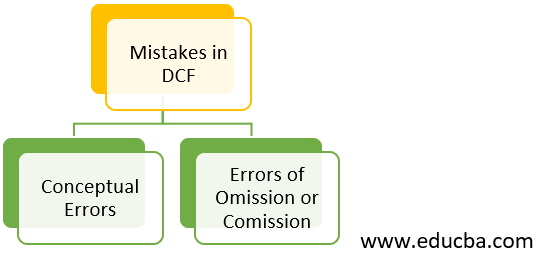Updated July 21, 2023

Introduction to DCF
Discounted Cash Flow model is a theoretical method of evaluating a stream of cash flow based on several assumptions related to cash flow projections, growth rate, and required rate estimations based on market conditions and risk involved, therefore as it is forward-looking, most of these inputs are approximations and can result in mistakes in evaluation.
Explanation
There can be two broad categories of mistakes:
- Conceptual Errors: We have heard of GIGO in computer studies, it stands for ‘Garbage In Garbage Out’ so, what we understand from this is that the model is as good as its inputs. In DCF, the inputs are estimates and approximations and therefore, the method may not lead to an accurate valuation if the estimates of inputs are too off the mark.
- Estimation Errors: Apart from estimation errors, there is also a possibility of calculation errors or errors of commission and omission which are caused due to neglect or oversight. While the latter is easier to correct, the former lead to deeper and more down rooted errors in the valuation and should be avoided at all costs because these can cause severe errors in evaluation.
Mistakes in DCF
Following are the areas which can cause concerns:
1. Selection of Investment Horizon
As we know that DCF is based on projected numbers and therefore, we need these for an optimum period of time. If the industry we are working with deals in products with a longer gestation period then taking an investment horizon that is too short is a mistake because that time is not enough for a company in this industry to bear fruit. Whereas, the opposite is true too, a company which should start earning profits in a short period of time as per industry average, should have a shorter investment horizon.
2. Discount Rate Calculation
We use various kinds of discount rates such as WACC or the cost of equity, as the case may be. Now calculating an appropriate discount rate is not an easy task. It requires several assumptions related to the risk of the project. Some companies undertake projects of various risks and therefore they can’t take up a blanket discount rate for all the projects. So there is a possibility of estimation error which can lead to over or undervaluation of the project.
3. Growth Rate Assumption
Some companies add a spread over the GDP growth rate or the industry average growth rate to come up with a company or a project-specific growth rate. These spreads may under or over estimate the potential of the project or company and therefore, lead to a misleading valuation.
4. Benchmark Errors
We know that the cost of equity is calculated using the CAPM approach which involves estimating the market risk premium. Finding an appropriate market index as a benchmark is not always possible. Some company or a project might be disruptive or innovative to the extent that there isn’t any close enough benchmark existing. This can lead to miscalculation of the cost of equity.
5. Beta Errors
CAPM approach involves estimating the beta coefficient of the stock, signifying the systematic risk. Generally, this is calculated using regression models and which further involve several statistical assumptions. GIGO plays out here quite well. The input to the regression model need to be robust to give an appropriate beta coefficient
6. Depreciation Error
We know that the time value of money plays out in the DCF valuation. The same cash flows in descending order will result in higher value at time 0 as compared to these in ascending order. Therefore choosing the appropriate depreciation method is very important because certain methods charge higher depreciation in earlier years. This will lead to higher cash flows in earlier years when depreciation is added back.
7. Inventory Assumptions Error
Similar to depreciation error, if we use FIFO inventory method in rising prices environment, then the net income will be higher and so the CF will also be higher. Errors in these assumptions can lead to over or under valuation.
8. Terminal Value Calculation Error
Terminal value involves assuming a perpetual growth in the years following the estimation and if this growth rate is not correct then the valuation can also be incorrect.
9. Choosing the Wrong CF Measure
We know that DCF can be conducted using Dividends, FCFF, FCFE, Residual income and so on.
- Suppose we use the DDM model while the dividends are not aligned to the profitability of the company, so this will lead to incorrect valuation.
- Or there can be a case that the company uses leverage in our capital structure, however, we value the company using the FCFE approach. This might become a problem when comparing with peers.
- There could also be a situation where the FCF is negative and we still use this approach
- Therefore, choosing the appropriate CF measure is of great importance.
10. Mismatch of CF Measure and Discount Rate
We know that DCF requires comparable FCF and discount rate measures. If we use FCFF, we need to use the WACC while if we use DDM or the FCFE approaches, we need to use the cost of equity for the valuation. However, there is a tendency in the evaluators to make mistakes of mismatch. This leads to incorrect valuation because at times WACC is lower than the cost of equity due to the presence of tax shield benefits for measuring the cost of debt.
This is more of an error of commission but it should be avoided to get the correct valuation and avoid making a wrong decision.
Conclusion
So we now understand what could be the mistakes in DCF valuation and how these can impact decision making. The most gruesome errors relate to the conceptual mistakes which can have dire consequences, however, the errors of omission and commission need to be avoided as these can be misleading as well. However, analysts fear the conceptual errors more as they are more difficult to correct and can have a cascading effect on all related calculations while the second category of errors is comparatively easier to rectify.
Recommended Articles
This is a guide to Mistakes in DCF. Here we discuss the definition and two broad categories of mistakes along with explanations and various mistakes in DCF. You may also look at the following articles to learn more –


